F flies are easy to tie and probably the most versatile dry fly patterns because they can imitate many insects inhabiting rivers and stillwaters. For example, emerging up-winged flies, caddisflies, and midges.
Also, if you’re new to fly tying, the simplicity of these dry flies makes them a great place to start your fly tying journey.
Since their creation in the early 1970s by Marjan Fratnik, F fly patterns based on a natural CDC feather wing have become popular and found in most dry fly boxes.
I never go grayling or trout fishing without several CDC dry fly patterns in my fly box, tied in different sizes and colours.
So, let’s take a look at…
How to tie the F flies I regularly fish:
First up is the olive F Fly. This CDC dry fly is my early-season go-to pattern that will work almost anywhere, whether you’re fishing rivers, streams, small stillwaters, or big reservoirs.
If you are new to fly tying, this is the pattern I would recommend you start with because it’s the simplest (only two materials) and will catch trout and grayling.
Tying material list:
- Hook: #14 to #18 HENDS BL354
- Thread: 8/0 Olive Uni Thread
- Wing: 2 CDC feathers

Step 1. Catch the waxed tying thread onto the hook 1 mm behind the eye. Wind the waxed thread, in touching turns, towards the hook bend and back up the shank, stopping 3 mm behind the eye.
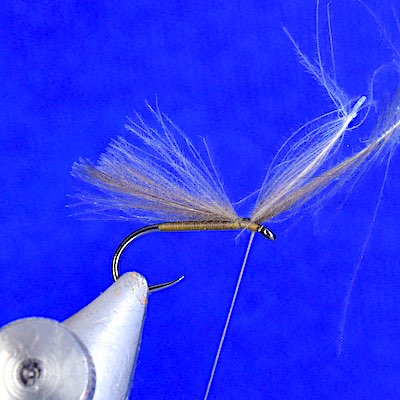
Step 2. Take 2 CDC feathers and place them side by side, making sure that the tips of the feathers are level. Catch them in position with two wraps of thread. Adjust the length of the feathers so that they slightly protrude past the hook bend. Now make another 3 or 4 wraps of waxed thread and trim the waste ends of the CDC feather.

Step 3. Build a small head with olive thread, whip finish, and coat with varnish to finish the fly.
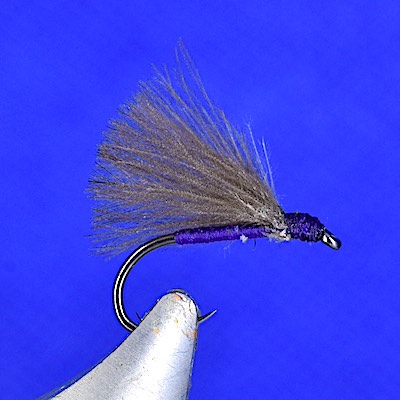
This purple body variant is tied using purple instead of olive thread.
I also tie these simple F flies using a range of coloured threads, e.g. black, purple, red, brown, yellow, and grey. This collection allows you to cover a multitude of emerging insects.
For example, a purple variant is often a winner during the summer when Iron blue duns are hatching,
Peacock Quill CDC F Fly
In addition to the thread-bodied CDC flies, I find a variation tied with a stripped peacock herl body an effective fly when the fish are fussy.
- Hook: #14 to #18 HENDS BL354
- Thread: 8/0 Olive Uni Thread
- Body: Stripped peacock quill
- Wing: 3 CDC feathers
Tying material list:
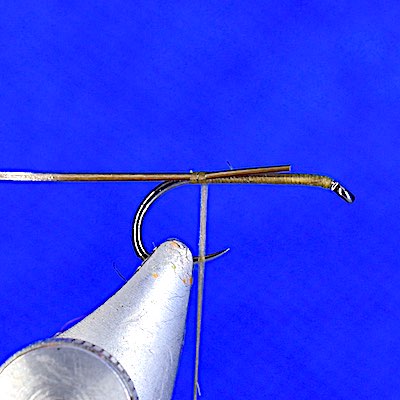
Step 1. Catch the thread onto the hook and wind down the shank in touching turns towards the hook bend. Next, take a stripped peacock quill and tie it in using the waxed thread.
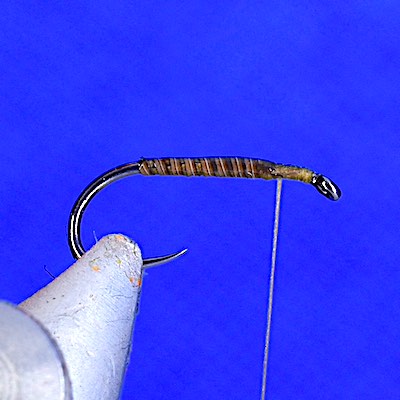
Step 2. Wind the waxed thread in touching turns up the shank toward the eye. Grip the peacock quill with a pair of hackle pliers and wind it up the hook shank in evenly spaced open turns. Tie in the quill with the thread, trim away the waste, apply a thin coat of varnish over the body and allow it to dry.
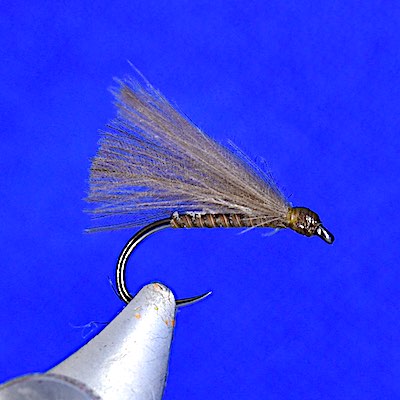
Step 3. Take 2 CDC feathers and place them side by side, making sure that the tips of the feathers are level. Catch them in position with two wraps of thread. Adjust the length of the feathers so that they slightly protrude past the hook bend. Now make another 3 or 4 wraps of waxed thread and trim the waste ends. Finally, build a small head with olive thread, whip finish, and coat with varnish to finish the fly.
The final pattern I carry in my fly box is an F fly tied with a peacock herl body, a deadly dry fly pattern for grayling fishing in autumn on the Welsh Dee.
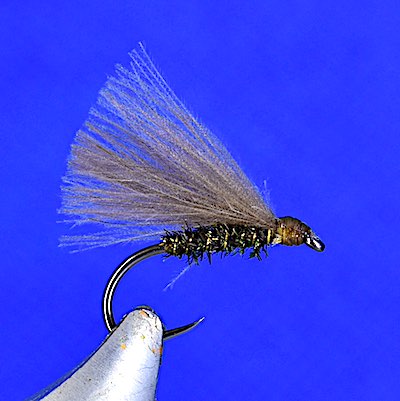
Peacock herl F fly
- Hook: #14 to 18 HENDS BL354
- Thread: 8/0 Olive
- Body: Peacock Herl
- Rib: Fine gold wire
- Wing: 2 CDC feathers
Sometimes, the addition of a short red tag to this CDC fly pattern improves its effectiveness.
How to fish F Flies.
On rivers and stillwaters, this class of CDC dry fly performs when trout and grayling are feeding on flies sitting in the surface film.
Equipment-wise, I use a 9ft 5# rod for dry fly fishing. Attached to the floating line is a 9ft 5X copolymer leader tipped with a 3 to 4 ft length of 3lb fluorocarbon. Fuller’s mud is applied to the fluorocarbon tippet to remove its shine and make it sink, while Mucilin grease is applied to the remainder of the leader so that it floats.
The only drawback of these dry flies is the CDC wing needs cleaning and drying after catching each fish to keep them afloat. However, it’s a price worth paying because of its effectiveness.
Keeping CDC Flies afloat:
It’s important to understand that it is the structure of the CDC feather that keeps them afloat.
Each fibre of a CDC feather contains thousands of tiny hairs that trap air, which is the primary floatation mechanism. In addition, oil from the duck’s preen gland waterproofs the feathers.

When necessary, I treat the CDC wing with a CDC oil-based floatant that restores the feather’s natural oils without clogging the tiny barbs (e.g. Veniards CDC Oil, TroutHunter CDC Fly dressing).
When the fly fails to float, I restore it by:
- Rinsing any fish slim off with water.
- Dry the wing thoroughly by squeezing it between a dry household microfibre cleaning cloth.
- Apply a tiny amount of CDC oil-based floatant between your thumb & forefinger and rub it onto the wing.
- Make a few false casts, and it’s ready to…
catch a few more trout and grayling.
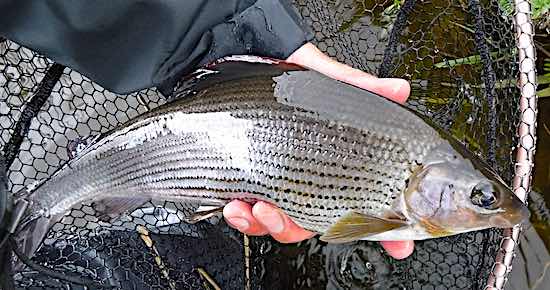
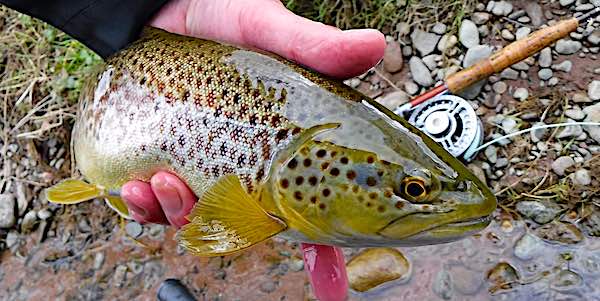
Finally, I hope this dive into CDC fly tying stimulates you to tie some F flies and test them at local fishing venues or take a trip to fish the Welsh Dee, where they catch fish when other dry flies fail.
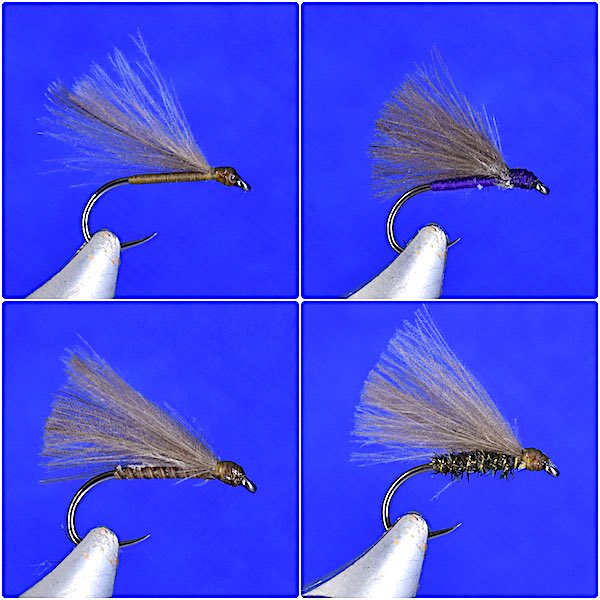
thanks andrew . good post again
Great to hear you enjoyed it.
Cheers.
ANDREW, I LOVE SIMPLE, KEEP THEM COMING.
Andrew I love simple, please keep them coming.
In my view most of the best flies are simple and I will be sharing a few more over the coming months.
I have never tied a fly. Reading around the subject. Most posts assume that the reader has already a certain knowledge of fly tying. This description with photos is very good
Hi Stan,
Thanks for the useful feedback on the post.
Cheers, Andrew
Great fly and info.
One thing needs correction
Frantik was not early 1900
My guess flies were tied in the 70’s.
Tied for Slovenia’s river Soca…tied with a lot of feathers.
Thanks
Thanks, correction made.
Andrew, another interesting blog. I do a simple variant that works well on both Dee and Alyn. I tie an IOBO Humpy that has a peacock herl body tied over the bottom end of two CDC feathers with the tips at the rear of the hook. After tying the body, I bring the CDC tips over the body and tie off just below the hook eye, putting a couple of turns of thread between eye and CDC feather tips. This has the effect of raising the tips. I tie this fly on various hook sizes but my most successful size is a size 17 Tiemco 103BL. The grayling in particular love this. Whether they take it for a midge or a small beetle I know not. It floats well but as with all CDC flies, needs drying off after a couple of fish. I just use kitchen towel instead on microfibre cloth but it seems to work.
Les
Hi Les,
Great to hear you enjoyed the post. I also tie and fish the IOBO for trout and grayling on the Welsh Dee – it’s definitely another great dry fly.
Tight lines, Andrew
Iain FRASER,
always a pleasure to read and use the info you put in your posts. I find F Flys work well on both still and running water – if there is any rivers that are flowing this time of the year. Just returned from the R. Ure in N.Yorks and it was dropping 4 inches each day. Thanks again for you valuable info and it was good to meet up with you on the R. Dee a few weeks ago. I wish I had been good enough to put into practice all your advice. I have had a miserable year on the rivers and still waters but at least I won’t have to fish all the competitions next year when I have my Golden Wedding as I have not qualified for anything this year. Tight Lines,
Hi Ian,
Great to meet you on the Dee. If you plan on fishing there again, just let me know and maybe we can fish together.
Cheers, Andrew
Great posts Andrew. The make you dream of your next fishing trip or at least get you to your tying bench. I would love to fish the River Dee.
Hi Keith,
Pleased to hear that you enjoyed the post. If you decide to make a trip to fish the Dee drop me a line.
Cheers, Andrew
Thanks for the sea trout information. It is really useful. I tend to fish the Mawddach, Lune and Wenning for sea trout and considering as the Dee is closest I have never fished it specifically for sea trout and I never seem to meet many anglers that do so your input was very welcome.
Hi Ian,
Great to hear you found it useful. I’ve fished the Wenning for sea trout a few times but only manage to catch brown trout. Maybe you can give me some advice on fishing the rivers you normally catch sea trout on?
Tight lines, Andrew
Thanks Andrew, most useful – as are all your posts
Cheers
Fantastic article, we need more like this. I have tied my own flies for years. Firstly on trial and error. I like small flies, on my local club water the fish are mainly stockies, around 2 to 3lb, with others to 14lb. So have to gear up to 4x and Partridge hooks size 14, 16, 18s.
Best on an olive F fly 9lb 4oz size 16 Partridge.
Hi Kevin,
That’s a lovely trout. Thanks for sharing your thoughts and picture.
Tight lines, Andrew
Thanks for these and your other articles – much appreciated!
I sometimes tie and use F flies using EP fibres; they need less maintenance than CDC, although I prefer the aesthetic of using CDC!
I prefer Malcolm Greenhalgh’s Cul De Carnard fly personally. It takes longer to tie as the wing is made from bunches of CDC fibres stripped off the stalk. The stalk is wound round the body to give the segmented abdomen effect. It is best tied ‘Scruffy’.
Great article Andrew.
Thanks Andrew for the step by step info, I don’t tie with cdc much but when I have I’ve put the feathers on top of each other and not had great results,I will try the side by side approach to see if that helps.